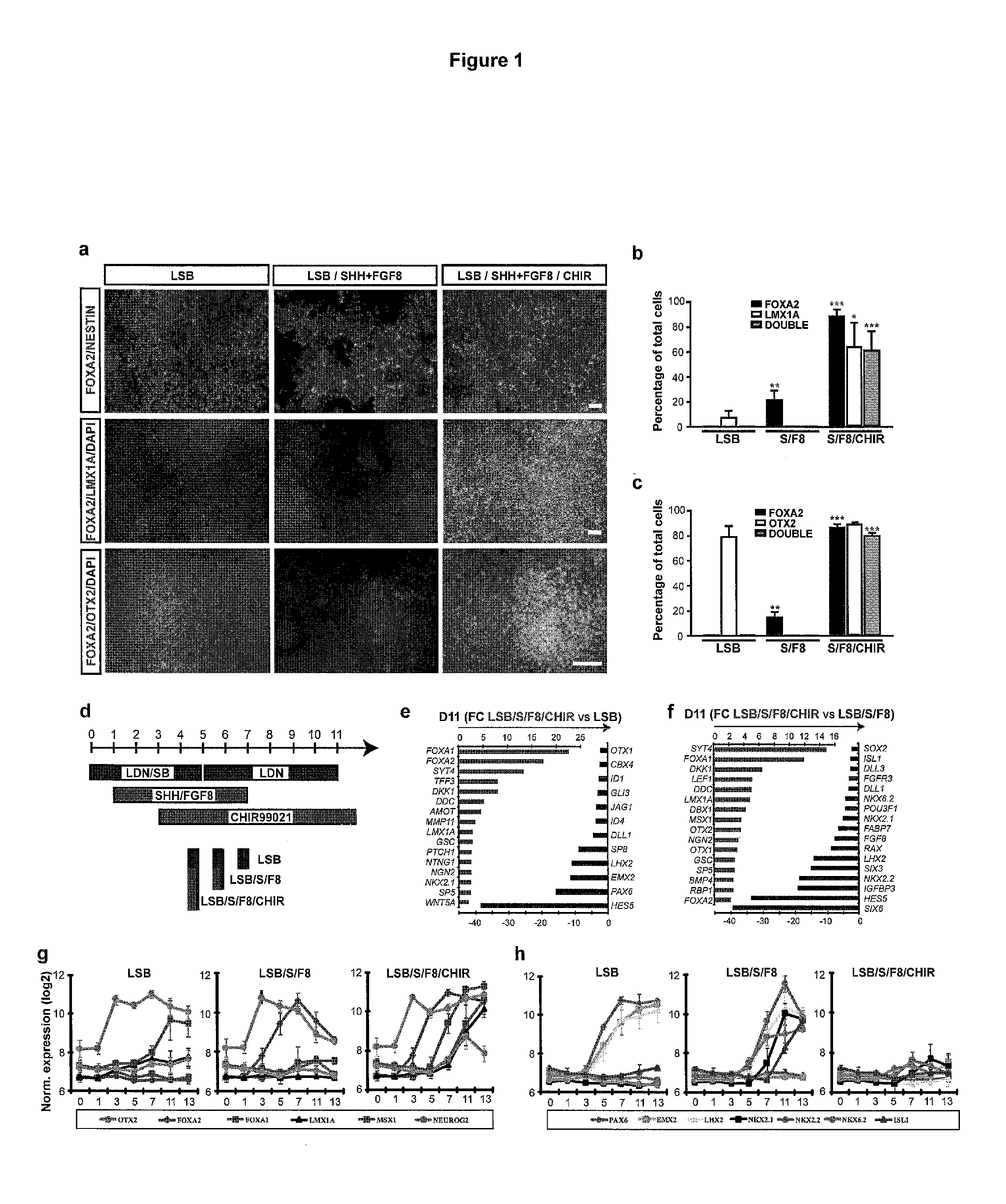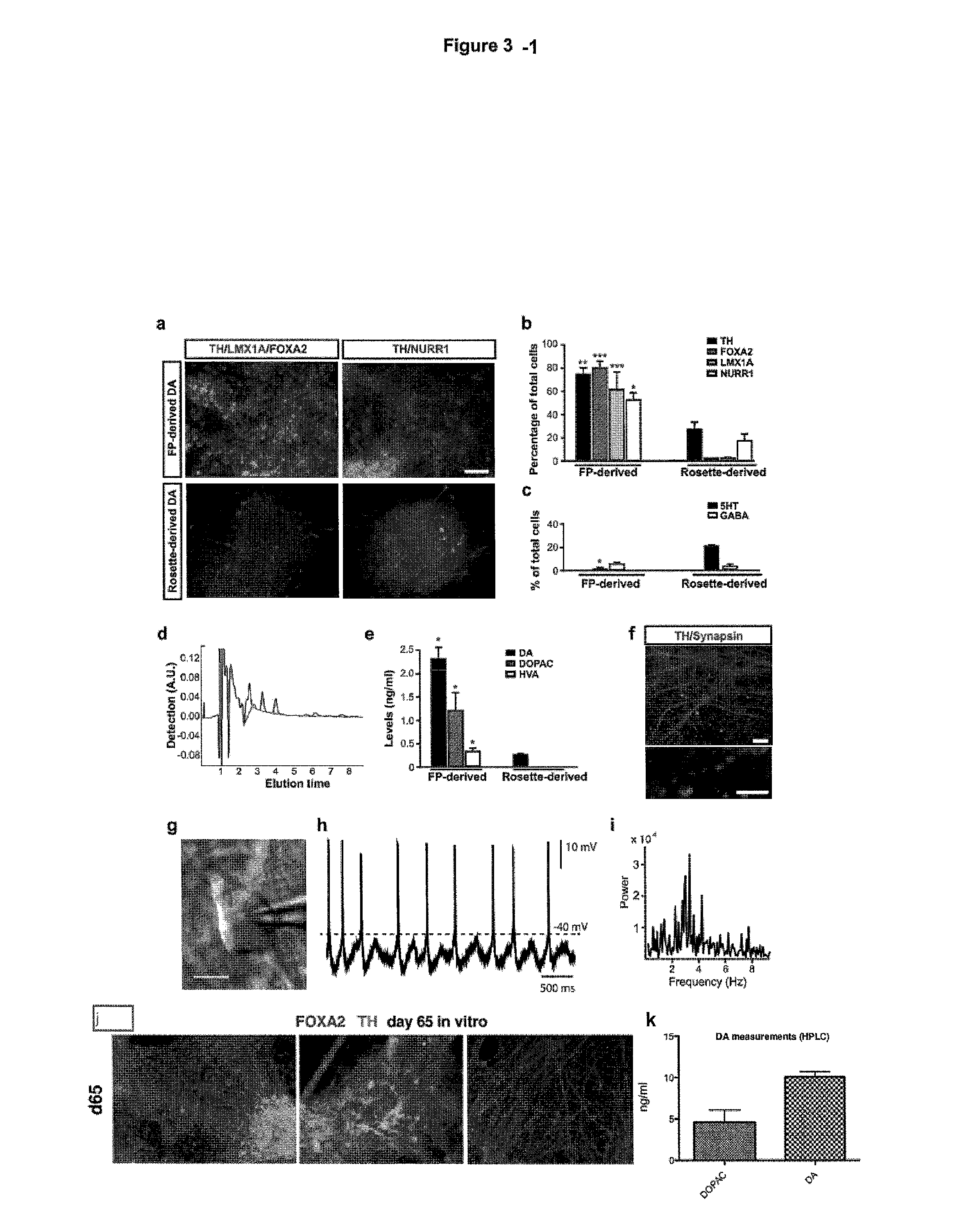Midbrain dopamine (DA) neurons for engraftment
a technology of dopamine and da neurons, applied in the field of stem cell biology, can solve the problems of growing unwanted tumors in patients, little capacity of these cells,
- Summary
- Abstract
- Description
- Claims
- Application Information
AI Technical Summary
Benefits of technology
Problems solved by technology
Method used
Image
Examples
example i
Materials and Methods
Methods Summary:
[0341]Human ESC (H9, H1) and iPSC lines (2C6 and SeV6) were subjected to a modified Dual SMAD-inhibition (Chambers, et al. Nat. Biotechnol. 27:275-280 (2009), herein incorporated by reference) based floor plate induction (Fasano, et al., Cell Stein Cell 6:336-347 (2010), herein incorporated by reference) protocol. Exposure to SHH C25II, Purmorphamine, FGF8 and CHIR99021 were optimized for midbrain floor plate and yield of novel populations of DA neuron (see FIG. 1d). Following floor plate induction, further maturation (days 11-25 or longer than 25 days in culture up to at least 100 days in culture) was carried out in differentiation medium based on Neurobasal / B27 in the presence of DA neuron survival and maturation factors (Perrier, et al. Proc Natl Acad Sci USA 101:12543-8 (2004), herein incorporated by reference) such as AA, BDNF, GDNF, TGFβ and dbcAMP (see full methods for details). The resulting DA neuron population were subjected to extensiv...
example ii
[0353]This example describes the discovery of small molecules and contact timing for providing directed differentiation of FOXA2+LMX1A+DA neurons of the present inventions.
[0354]The following is a brief summary of some of the experimental discoveries described herein: Treatment of Dual-SMAD inhibited cells with SHH agonists (purmorphamine+SHH) and FGF8 (S / F8) in the absence of CHIR99021 showed significantly lower expression of FOXA2 by day 11 and complete lack of LMX1A expression (FIG. 1a,b). The anterior marker OTX2 was robustly induced in LSB and LSB / S / F8 / CHIR treated cultures, but not under LSB / S / F8 conditions (FIG. 1a,c).
[0355]The inventors previous used several other directed differentiation methods that resulted in cell populations containing DA-like neurons. These DA-like neurons were used in transplantation studies that resulted in concerns on the further use of these cells for therapeutic applications. For examples, procedures described in Perrier et al., 2004 and Fasano et...
example iii
[0360]Differentiation of DA neurons. For further differentiation, precursor cells were maintained in a medium promoting neuronal maturation (BAGCT—see material and methods). The following types of comparisons were made between the populations of differentiated cells resulting from previous methods and methods of the present inventions: A) Immunocytochemical analysis at day 50 of differentiation for TH in combination with LMX1A, FOXA2 and NURR1, B) Quantification of TH+, FOXA2+, LMX1+, and NURR1+ cells out of total cells comparing rosette-derived versus floor plate-derived (LSB / S / F8 / CHIR) cultures. C) Quantification of the percentages of serotonin+ (5-HT), and GABA+ neuronal subtypes (non-DA neuron contaminants) at day 50 in floor plate and rosette-derived DA neuron cultures. And D) HPLC analysis for measuring dopamine and metabolites: Comparison of the DA, DOPAC and HVA levels between floor plate versus rosette-derived cultures. By day 25, three precursor cell populations yielded Tu...
PUM
| Property | Measurement | Unit |
|---|---|---|
| Fraction | aaaaa | aaaaa |
| Fraction | aaaaa | aaaaa |
| Fraction | aaaaa | aaaaa |
Abstract
Description
Claims
Application Information
 Login to View More
Login to View More - R&D
- Intellectual Property
- Life Sciences
- Materials
- Tech Scout
- Unparalleled Data Quality
- Higher Quality Content
- 60% Fewer Hallucinations
Browse by: Latest US Patents, China's latest patents, Technical Efficacy Thesaurus, Application Domain, Technology Topic, Popular Technical Reports.
© 2025 PatSnap. All rights reserved.Legal|Privacy policy|Modern Slavery Act Transparency Statement|Sitemap|About US| Contact US: help@patsnap.com



